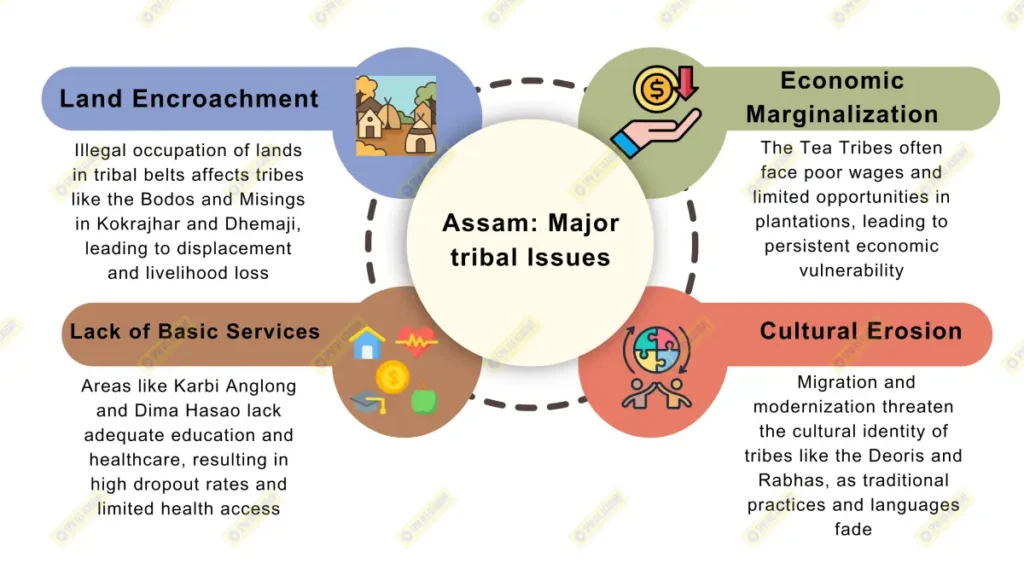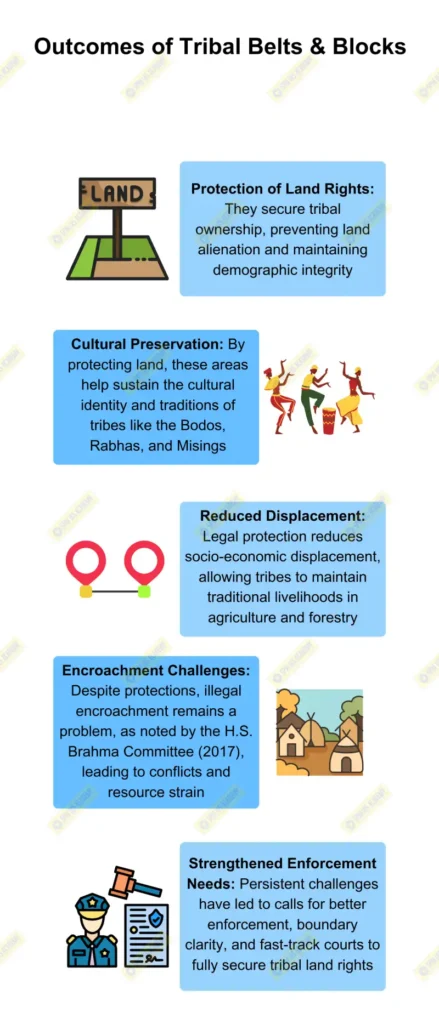In Assam, tribal belts and blocks are specially designated areas created to protect the land rights of indigenous tribal communities. Established under the Assam Land and Revenue Regulation Act of 1886, these belts and blocks restrict land ownership to tribals, aiming to prevent the alienation of tribal lands to non-tribal populations. Despite these protections, tribal land alienation remains a pressing issue, driven by various socio-economic and administrative challenges.
Reasons for Tribal Land Alienation in Assam
- In-Migration and Population Pressure: The large-scale influx of migrants from neighboring regions has intensified demand for land, leading to illegal encroachments on tribal lands. The H.S. Brahma Committee (2017), tasked with examining land rights issues in Assam, highlighted that a significant portion of tribal land had been occupied by non-tribals, altering the demographic and cultural fabric of tribal belts and blocks. Assam’s first Chief Minister, Gopinath Bordoloi, had foreseen this risk and advocated for safeguarding Assam’s indigenous population, laying the groundwork for protected tribal areas under the Sixth Schedule.
- Weak Implementation of Land Regulations: Although laws like the Assam Land and Revenue Regulation Act exist to protect tribal land, the Brahma Committee noted that enforcement remains weak, with numerous illegal transfers due to loopholes and insufficient monitoring. Similarly, the R.P. Sharma Committee (2010) on illegal encroachment in Assam identified lax enforcement and recommended stronger measures, including fast-track courts for land disputes and regular demarcation of tribal belts.
- Economic Pressures and Poverty: Economic hardship often compels tribal individuals to sell or lease their land to non-tribal buyers at low prices, especially during financial crises. Tribal leader Bhimbor Deuri, who strongly advocated for protecting tribal land and autonomy, warned of the risks posed by such economic vulnerabilities, emphasizing the need for economic stability to preserve indigenous lands.
- Lack of Awareness and Education: Many tribal individuals are unaware of their legal rights under land protection laws, making them vulnerable to exploitation. Bhimbor Deuri’s activism focused on educating tribal communities about their rights, an approach echoed by the Brahma Committee’s recommendation for regular awareness campaigns to prevent exploitation.
- Industrial and Infrastructure Development: Government and private projects sometimes acquire tribal land, leading to displacement without adequate compensation. The Brahma Committee emphasized sustainable development that respects tribal rights, while anthropologist Verrier Elwin’s principle of non-interference in tribal lands underlines the need to limit external disruptions that jeopardize indigenous communities.

Measures to Check Tribal Land Alienation
- Strengthen Enforcement of Land Laws: Following the Brahma and R.P. Sharma Committees’ recommendations, strict monitoring and fast-track courts for land disputes should be implemented to protect tribal belts effectively. Regular demarcation of boundaries and severe penalties for encroachments are essential.
- Economic Development and Livelihood Support: Providing sustainable livelihood programs can reduce economic pressures on tribal communities. Initiatives like ecotourism and community-based forestry align with Deuri’s vision of empowering communities economically, as well as with the Brahma Committee’s recommendations for economic resilience.
- Land Awareness Programs: Conducting awareness campaigns on land rights and the consequences of alienation can empower tribal communities. Bhimbor Deuri’s efforts to raise awareness about tribal rights highlight the importance of this approach, which the Brahma Committee also advocates.
- Strengthening Tribal Representation in Governance: Ensuring active tribal representation in governance can help safeguard land rights. Empowering local panchayats or autonomous councils aligns with Gopinath Bordoloi’s call for tribal autonomy and decision-making authority in land matters.
- Community Land Ownership Models: Encouraging community-owned land models, where land is collectively owned, can prevent individual sales to non-tribals. This approach has shown success in other Northeastern states and echoes Deuri’s vision of collective ownership as a shield against land alienation.
Protecting tribal lands in Assam is crucial not only for economic resilience but also for preserving the cultural heritage, identity, and autonomy of indigenous communities, deeply tied to their “Jal, Jangal, Zameen” (Water, Forest, Land). Recognizing this, the government’s vision of “Sabka Saath, Sabka Vikas, Sabka Vishwas, Sabka Prayas” underscores the need for inclusive development that respects tribal rights.













